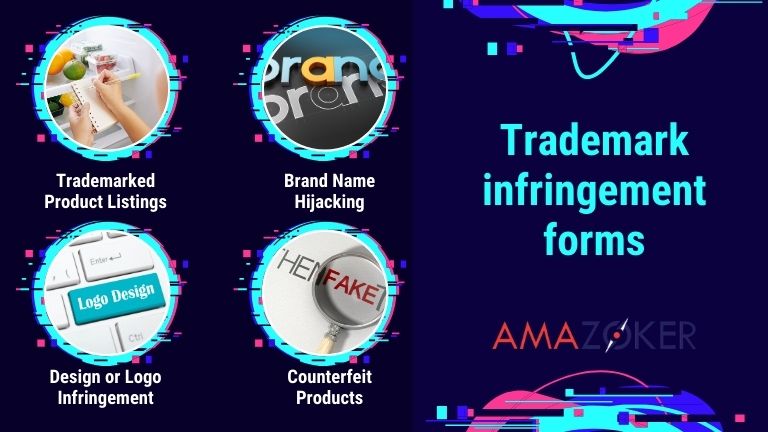In the world of Amazon sellers, with the platform’s popularity comes the risk of Amazon trademark infringement, which can have serious consequences for sellers. Let’s explore the concept of Amazon trademark infringement, and how sellers can respond to and avoid trademark infringement issues on the platform.
Table of Contents
What is Trademark Infringement on Amazon?
Trademark infringement on Amazon refers to the unauthorized use of a registered trademark or the creation of a product or listing that confuses or misleads consumers into believing it is associated with or endorsed by the trademark owner. It occurs when a seller on Amazon uses a trademarked name, logo, or design without proper authorization from the trademark owner.
Trademark infringement can take various forms on the Amazon platform, including:
- Counterfeit Products: Selling counterfeit versions of branded products, which are unauthorized replicas that infringe on the trademark owner’s rights.
- Trademarked Product Listings: Creating product listings/category listing that use trademarked names, logos, or designs without authorization, leading consumers to believe the product is associated with the trademark owner.
- Brand Name Hijacking: Registering a brand name or trademark that is similar to an existing brand and using it to sell unrelated products, causing confusion among consumers.
- Listing Title or Description Infringement: Using trademarked terms or phrases in product titles or descriptions without permission, leading to consumer confusion or misrepresentation.
- Design or Logo Infringement: Using trademarked designs or logos without authorization, either in product images, packaging, or branding.
Trademark infringement on Amazon is taken seriously, as it can harm both the trademark owner and consumers.

There are multiple forms of trademark infringement that can occur on the Amazon platform
Amazon Trademark Infringement Policy
Amazon has a strict Trademark Infringement Policy in place to protect the intellectual property rights of trademark owners and maintain a fair marketplace for sellers. The policy outlines the rules and guidelines that sellers on Amazon must adhere to regarding trademarks. Here are the key points of Amazon’s Trademark Infringement Policy:
Prohibited Activities
Sellers are prohibited from using trademarks, logos, or brand names that infringe on the intellectual property rights of others. This includes using trademarks without proper authorization or creating listings that mislead or confuse customers into believing they are associated with a particular brand.
Trademark Ownership
Amazon recognizes the importance of trademark ownership. Sellers are only permitted to use trademarks if they have the explicit authorization from the trademark owner or if they are the registered trademark owner themselves.
Counterfeit Products
Selling counterfeit products, which are unauthorized replicas of trademarked goods, is strictly prohibited on Amazon. Counterfeit listings are subject to removal, and sellers found engaging in such activities may face penalties, including account suspension or closure.
Brand Registry Program
Amazon offers a Brand Registry program to help trademark owners protect their intellectual property rights. This program allows trademark owners to enroll their registered trademarks, providing enhanced brand protection tools and mechanisms to report and remove infringing listings.
Reporting Infringements
Trademark owners can report infringement through Amazon’s reporting mechanisms, such as the Brand Registry program or the Report Infringement form. Amazon investigates and takes appropriate action against reported infringements, including removing infringing listings and taking disciplinary measures against sellers found guilty of infringement.
It’s important for sellers on Amazon to familiarize themselves with Amazon Trademark Infringement Policy and ensure they comply with its guidelines. Violations of the policy can lead to severe consequences, including account suspension or closure. Additionally, trademark owners should actively monitor their trademarks on the platform and take appropriate actions to protect their intellectual property rights.
How to Respond to an Amazon Trademark Infringement
If a seller receives a notice of trademark infringement from Amazon, it is important to take immediate action to address the issue. Follow these steps to respond to an infringement claim:
- Understand the Claim: Carefully review the infringement claim to understand the specific allegations against your product or listing.
- Gather Evidence: Collect all relevant evidence, including proof of your ownership of the trademark, product images, and any communication with the claimant.
- Craft a Response: Prepare a well-written and concise response addressing each allegation and providing evidence to support your case.
- Submit the Response to Amazon: Submit your response through the appropriate channels, such as the Amazon Seller Central platform or the Brand Registry portal.

Effective Approaches to Responding to an Amazon Trademark Infringement
In cases where your initial response does not resolve the issue, or if you believe the claim was made in error, you may need to file an Amazon appeal. Here’s how to proceed:
- Review Amazon’s Guidelines for Appeals: Familiarize yourself with Amazon’s guidelines for filing an appeal. Understand the grounds on which you can base your appeal and the specific requirements for submitting an appeal.
- Prepare Additional Supporting Evidence: Gather any additional evidence or documentation that strengthens your case. This may include product images, sales data, or any other information that demonstrates your compliance with Amazon’s policies and refutes the infringement claim.
- Craft a Compelling Appeal: Write a clear and persuasive appeal letter that clearly states the reasons for your appeal. Include a detailed explanation of the evidence you are submitting and emphasize your commitment to resolving the issue.
- Monitor and Follow Up: Monitor the progress of your appeal and promptly provide any requested information or documentation. Be patient, as the appeal process may take some time. Follow up with Amazon if necessary to ensure your appeal is being reviewed.
To navigate the complex process of responding to trademark infringement claims on Amazon and to receive professional assistance, consider utilizing services like Amazoker. Amazoker specializes in helping sellers protect their brands and navigate the intricacies of Amazon’s policies. They can provide valuable guidance, support, and expertise throughout the response and appeal process.
Remember, it’s essential to address Amazon trademark infringement claims promptly and professionally to protect your brand and maintain a positive reputation.
How to Avoid Trademark Infringement on Amazon
Preventing Amazon trademark infringement is the best way for sellers to protect their businesses and avoid potential legal issues. Here are some proactive measures to help you avoid trademark infringement on Amazon:
- Conduct a Comprehensive Trademark Search: Before selling on Amazon, conduct a thorough trademark search to ensure that your brand name, logo, or design does not infringe on existing trademarks.
- Register Your Trademark: Register your trademark with the appropriate authorities to establish legal protection and enhance your ability to enforce your rights on Amazon.
- Respect Intellectual Property Rights: Always respect the intellectual property rights of others. Do not use trademarks, logos, or copyrighted material without proper authorization or permission from the rightful owner. This includes avoiding the use of similar-sounding or look-alike brand names or logos.
- Be Diligent in Product Research: When sourcing products for sale on Amazon, ensure that they do not infringe on any trademarks. Research the products thoroughly, including their branding, packaging, and design elements, to avoid inadvertently selling infringing items.
- Create Unique Branding: Develop a distinctive and unique brand identity for your products. This includes creating original logos, product names, and packaging designs that are unlikely to cause confusion with existing trademarks. Conduct a trademark search to ensure your branding is not already in use.
- Monitor Your Brand: Regularly monitor your brand presence on Amazon to identify any potential cases of infringement. Utilize tools and services like Amazoker to proactively protect your trademark and monitor unauthorized use.
- Consult with Trademark Professionals: Consider consulting with trademark professionals or attorneys who specialize in intellectual property law. They can provide expert advice, assist with trademark registration, and help you navigate any potential infringement issues.

Tips for Preventing Trademark Infringement on Amazon
In conclusion, Amazon trademark infringement is a serious issue that can have significant consequences for sellers. By staying informed and proactive, sellers can minimize the risk of trademark infringement and continue to thrive in the competitive e-commerce marketplace.











